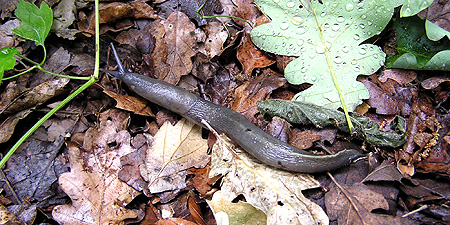
A rather grey coloured specimen of the black keel back slug (Limax cinereoniger) crawling on
Wilhelminenberg hill in Vienna. Note the distinctive white stripe on the slug's back. [RN]
Limacidae Rafinesque 1815
 A rather grey coloured specimen of the black keel back slug (Limax cinereoniger) crawling on Wilhelminenberg hill in Vienna. Note the distinctive white stripe on the slug's back. [RN] |
Table of Contents:
Note:
![]() leads back to
the top of the page!
leads back to
the top of the page!
![]() Keel back slugs (Limacidae) in the molluscs.at discussion board.
Keel back slugs (Limacidae) in the molluscs.at discussion board.
Among the keel back slugs (Limacidae), there are the largest of all terrestrial slugs. Distinctive from the common slugs in shape and colour, the keel back slugs also show a distinctive pattern of behaviour, especially in the remarkable way of mating in many species.
In contrary to the smaller garden keel back slugs (Agriolimacidae) the large keel back slugs in general are usually less harmful to gardens and other cultivated areas and so can hardly be called a pest. The two best known large species of keel back slugs are the great grey slug, also known as leopard slug (Limax maximus), and the black keel back slug (Limax cinereoniger).
Even if the systematic name Limax maximus indicates this species to be "the largest" slug, it is Limax cinereoniger, which merits that title. With an overall length of more than 20 cm (8 in.), the black keel back slug is the largest terrestrial slug worldwide. Compared to that the leopard slug grows to a maximal length of a mere 15 cm (6 in.), though those features are subject to discussion.
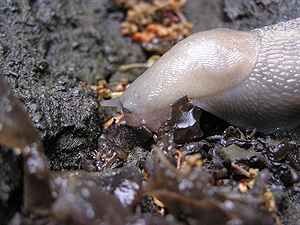 In contrary to the leopard slug, the black keel back slug lives in forests, usually avoiding cultivated areas. [RN] |
The leopard slug, as its name says, is often recognized by a leopard or tiger shape pattern of stripes and blotches. The black (or literally ash-black) keel back slug on the other hand, is often not black: In the contrary, there often are more lightly coloured varieties, which appear rather grey than black. But there usually is a distinctive white keel stripe on the slug's back.
The easiest way to tell both species apart is to have a look at their foot soles: In Limax maximus, it will be completely white or cream-coloured, in Limax cinereoniger, it will be white only in the centre, the margins being distinctively darker, sometimes black.
![]() The foot sole of a Limax cinereoniger: A Picture by Clemens M. Brandstetter.
The foot sole of a Limax cinereoniger: A Picture by Clemens M. Brandstetter.
There is another large keel back slug with an interesting colour: In the Carpathians and adjacent mountain ranges dwells Bielzia coerulans, and it is blue! This species is found neither in Germany nor in Austria, but in the High Tatra of Slovakia and the Czech Republic, as well as in more eastern Carpathian countries, as far East as the Ukraine.
Systematically, Bielzia is placed in a subfamily alone for itself, the Limacopsinae Gerhardt 1936 (see Mollbase).
![]() Bielzia
coerulans on biolib.cz.
Bielzia
coerulans on biolib.cz.
![]() Bielzia coerulans on wikipedia (English version).
Bielzia coerulans on wikipedia (English version).
![]() Walter Pfliegler:
A movie of
Bielzia coerulans on youtube.
Walter Pfliegler:
A movie of
Bielzia coerulans on youtube.
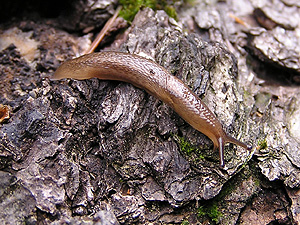 In contrary to its larger relatives, the tree keel back slug (Lehmannia marginata) only grows to 75 mm (4 in.). [RN] |
There are several much smaller species of keel back slugs, such as the yellow slug or beer slug (Limacus flavus), whose name is due to the fact that this slug was often found in cool moist places such as beer cellars, where it is attracted by pools of spilled beer. A very similar species is the Irish yellow slug (Limacus maculatus), which in Britain is often found in the same habitats, but which also is present in several countries of the former Soviet Union, starting fro the Crimea and the Caucasus.
The toadstool slug (Malacolimax tenellus) mainly feeds on toadstools, algae and lichen, as does the tree slug (Lehmannia marginata), which, specialized on this diet, is found mainly on tree trunks.
Another species is the three band garden slug (Lehmannia valentiana), often introduced by man in anthropogenous habitats like gardens, greenhouses and nurseries. The three band garden slug has also been introduced to the USA, for example to the West Coast.
Distinction from other slug groups
![]()
Another group of large slugs is the Arionidae, among it the notorious Spanish slug (Arion vulgaris). In European species, the shell has been almost completely reduced to some mere limestone grains below the mantle shield. In contrary to them, the keel back slugs, similar to the cuttlefish among the cephalopods, still do have a small internal shell, a reminder that slugs once evolved from snail forbears bearing shells. This today can still be seen in gastropod groups like the glass snails (Vitrinidae) and the carnivorous semi-slugs (Testacellidae).
![]() The mollusc of the year 2005: The rudimentary shell
is displayed in this folder on the leopard slug (Limax maximus Linnaeus 1758).
The mollusc of the year 2005: The rudimentary shell
is displayed in this folder on the leopard slug (Limax maximus Linnaeus 1758).
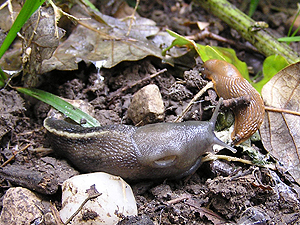 Black keel back slug (Limax cinereoniger, in front) and Lusitani- an slug (Arion cf. vulgaris). [RN] |
Apart from that the more slender shape of the body and the distinctive keel make a keel back slug different from an Arion slug. The keel becomes most prominent, when a keel back slug contracts to protect itself.
This is the place to mention that keel back slugs of the Limacidae family are by no means the only slugs with a back keel: Milacidae possess an even more prominent keel, which extends over all of the slug's back, from tail tip to mantle shield, contrary to a Limax keel that only covers about half that distance.
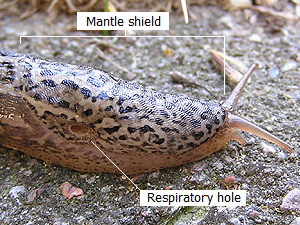 A keel back slug's (this is Limax maximus) pneumostome is located in the rear half of the mantle shield. [RN] |
An easy means of telling the difference between a keel back slug and an Arion slug is to have a look at the respiratory hole: In a Limax this pneumostome will be in the rear half of the mantle shield; in an Arion it will be in the front half.
![]() Common slugs: Arion and Limax slugs in comparison.
Common slugs: Arion and Limax slugs in comparison.
While in Germany and Austria the number of large keel back slug species is basically restricted to Limax maximus and Limax cinereoniger, in Italy, on the other hand, there are very many different keel back slug species, each of which has a distinctive copulation biology and whose division into species is still subject of scientific research. It is assumed that keel back slugs are a very old group whose origins can be retraced as far as the Pleistocene (see Geological Timeline). At that time, keel back slugs may have developed on islands, which would explain their very various copulation biology (see below). Why the copulation among keel back slugs so often takes places in such a dangerous and spectacular way, is so far undetermined by science.
Limax maximus, for example, is well known to mate hanging from the end of a self-made mucus 'Bungee-rope'. Limax cinereoniger prefers to at least partly keep contact to the ground. But even so it mates hanging from a wall or tree.
|
|
The mating of the leopard slug: Picture series by Martina Eleveld. | |
|
|
The mating of the leopard slug: YouTube playlist by Martina Eleveld. | |
|
|
Vergleichende Studien zu Limax-Kopulationen (Comparative studies of Limax copulations): A poster of the German Malacological Society meeting in Badenweiler 2008 (PDF, 288 KB) | |
|
|
Accoppiamento Limax ilvensis Falkner & Nitz 2010: The mating of another, recently described, Limax species from the island of Elba (Movie on youtube). |
The leopard slug (Limax maximus) has been introduced from its original distribution area to North and South America, as well as to the Hawaiian Islands, Australia and New Zealand. There it is considered foreign to the indigenous fauna (a so-called neozoon) and partly to be a garden pest.
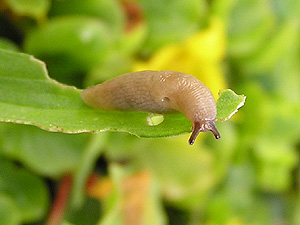 The netted field slug (Deroceras reticulatum, Agriolimacidae) shares a superfamily with the keel back slugs. [RN] |
The number of species in the Limacidae family is not clearly known.
In the book "Weichtiere" (1990), Falkner states an approximate number of 100 species in the
northern Palaearctic (![]() See Faunal provinces), but even today new species are
found and discussed on a regular basis.
See Faunal provinces), but even today new species are
found and discussed on a regular basis.
Interesting research areas, apart from Corsica and the Alps also are the South European mountain ranges. An emphasis on research currently is put on Italy.
In the literature, keel back slugs appear with different original authors: Apart from the first mentioning of Limacidae Lamarck 1801 (as stated, for example, in the Checklist of European Continental Mollusca, CLECOM, which is usually considered as the final authority in matters of mollusc systematics), found today are mainly the Limacidae Gray 1824 according to the American and Canadian way of thinking (as in Forsyth, R. G., 2004) and the older and so principally valid mentioning of the Limacidae Rafinesque 1815, for example according to the nomenclature list Mollbase of the German Malacozoological Society.
In this nomenclature list, the suggestion is made to combine the limacids with the two related families of the garden keel back slugs (Agriolimacidae H. Wagner 1935) and the Boettgerillidae van Goethem 1972 to form a superfamily called Limacoidea Rafinesque 1815.
However, the state of this superfamily is not yet secure, as there is also another suggestion by B. Hausdorf to form a superfamily Limacoidea s.l. combining "all limacoid and zonitoid groups as suggested and justified by H.B. Baker (1941)". For this systematic model, a "reconstruction of phylogeny and a revision of the system" are to be waited for.
It must also be stated clearly here that the garden keel back slugs (Agriolimacidae), such as the Deroceras genus, make a family of their own (see Likharev & Wiktor 1980: 409-488) and so are not to be counted among the Limacidae, but only, together with them, in a common superfamily.
Complete species list for the UK and Ireland
![]()
According to Anderson, R. (2008):
Annotated List of the Non-Marine Mollusca of Britain and Ireland,
as of June 2008)
Limacidae Lamarck, 1801
Limacinae Lamarck, 1801
Limax Linnaeus, 1758
Limax maximus Linnaeus, 1758
Limax cinereoniger Wolf, 1803Limacus Lehmann, 1864
Limacus flavus (Linnaeus, 1758)
Limacus maculatus (Kaleniczenko, 1851)Malacolimax Malm, 1868
Malacolimax tenellus (O.F. Müller, 1774) – UK
Lehmannia Heynemann, 1863
Lehmannia marginata (O.F. Müller, 1774)
Lehmannia valentiana (A. Férussac, 1822)